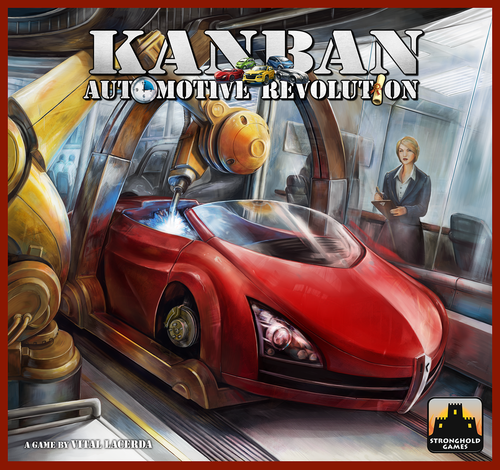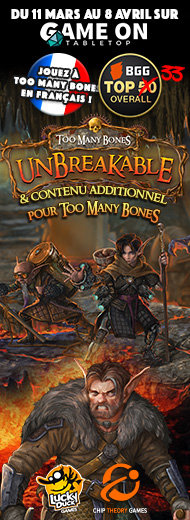Kanban: Automotive Revolution (V Eng)
SwatSh: 9,5 /10
Kanban is, with the expansion of Space Cadets Dice Duel, the expansion of Core Worlds and Panamax, one of the many new games of a publisher that we appreciate more and more by Vin d’jeu: Stronghold Games. Indeed, they are no afraid to publish experts games, for our pleasure of course. Indeed, we note that the board games « family » or “family+ » is changing a lot with an increase of the number of annual published games and with the quality of those games. The more « experts » games remains until now quite confidential. The number of sales of this type of game is still very limited. I therefore welcome especially the few courageous initiatives to publish such complex games with high quality. Stronghold games thank you!
The author
Vital Lacerda, the author of Kanban, he too is not afraid. He is not very productive since its first game, Vinhos (our game of the year 2011) and CO2 (one of our 2013 favorites games). In other words, Kanban is his third game in 4 years. But that’s normal as the depth of these games, the multitude of mechanisms, originality and complexity. It has to take a long time to design, test and balance Kanban. Hats off and thank you Mr. Vital to be one of the few contemporary authors (with my friend Uwe course:-)) to create games of such depth.
The theme & its integration into the mechanics
Kanban is a company that manufactures cars. The game put us really into the world of business with a unique and realistic way. Power Struggle has already managed to dive into this universe but Kanban goes a little further. Welcome into the corporate world, to the point that some are wondering if you can call it still a game 
But that’s not all! Everything in the game reflects the world of business. You will have to allocate your time as efficiently as possible between training, produce the various parts required for the manufacture of a car, homework to fill in your free time ;-), support the assembly line, recycle the car parts, go to the warehouse, test cars, progressing in your HR certificates, …
The top of it is the organization of meetings. When the company produces enough cars, Sandra will organize a meeting where each manager (= player) will be able to talk about different topics. Talk about a subject is equivalent to complete certain goals and win the corresponding VPs. At each meeting, 4 subjects are on the table. So players have four goals, visible to all from the beginning of the game. After a meeting, four new goals will be on the table allowing players to guide their actions and strategies to achieve them. The thing is that we do not talk all at once at a meeting and it will be the most trained player who can speak first (= realize the first goal). And when you talk about a subject after another colleague has spoken over it (= achieve an objective after another has achieved it), Sandra will listen less carefully than before and you will receive less VPs. In Kanban, we do not speak about VPs but about PPs, performance points, with pleasure my dear
But that’s not all, each player has also three objectives cards in his hand and will have to perform one = talk about his pet project even if he has done it miserably, he must talk to Sandra about it during the meeting. And the others will also be able to speak about it (= achieve the objective (pet project) of the other players). But the speaking time of each is limited, you have to work effiency in Kanban! This is represented by seats around the table. Via different types of actions, « sub-goals » to achieve in the game, we will be able to get seats. With 1 seat you can talk about a subject = achieve 1 objective.
The mechanics of the meeting is really fabulous as it represents well the theme and immerses players in it. But also, the meeting’s mechanics gives almost infinite variety to the game. In every game of Kanban, you will participate in 2 or 3 meetings, which means that you will have the opportunity to realize between 8 to 12 different objectives in each game (for 3 players it’s a little less). In addition, during the preparation, we will randomly draw three general objectives to achieve that represent the long-term strategic plan of the company. Customers will also play their role by asking some car colors (= goal to produce these cars rather than others), and each department will also have targets. A multitude of purposes so that your games will vary considerably. It will also strangly complicate the game!
The central mechanic and the sub-mechanics
The Kanban central mechanic is a worker placement mechanic. But again, Vital has created a rather original worker placement mechanic. First of all, no, I have not done any misspelling, you’ve well readen, « worker » with no « s »! Yes, you have only 1 worker and that 1 will never do more. And no, we don’t make children in the business of Kanban 
– In each department you will be able to perform different actions. Note also that, as in Vinhos, each department has its own mechanism which is always very original and could be a game in itself. It gives me every time a great “game pleasure” to discover the ingenuity of this uncommon author.
– 2 action boxes are available in each department, a box allows for two actions while the other 3. Obviously, if you choose 3 actions, you have to play after the one who do realises 2. The choice between these two boxes is really difficult and a little risk-taking may be necessary from time to time …
– The various objectives
– The actions you want to perform afterwards. This is a very strategic part of Kanban, since you will plan your actions several turns in advance and not just follow a certain sequence. You will also pay attention to be well placed to be able to choose one or another action box after the one you are in.
This worker placement mechanic can be quite frustrating because if you do it not well or if the circumstances of the game provoke that the other players are blocking you, you’ll have to wait many turns before that you will be able to perform a particular type of action.
Conclusions
Kanban is clearly the follow-up of Vinhos as it offers a very similar type of game:
– An original action choice mechanism, without random. Those actions present sub-actions with always a sub-original action choice sub-mechanism!
– A well represented theme where the player are involved from the beginning to the end of the game.
– A complexity offering a certain heaviness which can be confusing during the first games. This complexity also brings an important depth and strategies to the game.
– A long life of the game with almost infinite variety of games.
– Unique happiness for all strategic game’s lovers who are not afraid of 90 minutes explanation of the rules.
________________________________________________________
Eager to test this Kanban, I ended the game with some questions that I still can’t answer. Now that I write this « critique », may be I’ll find the beginning of an answer?
First, the feeling after our first game. I ended last, way behind all the others. This is a game about cars and I ended it without any car in my garage at the end of the game. Normal then that I ended last: one good point for the game.
Now, I have the impression that, in a 4 players-game at least, there is a big chance that 2 will catch the « move » of the game while two will be missing it. Indeed, for each department, there are only 2 spots for workers and some actions need to be performed before some others. If you miss one, the cars you were looking at getting are gone and you must « push » other cars through the chain until one suits you. In addition, while you do this, trying to get back in, the others prepare for the next wave.
It is clear that during this first game, I was completely « counter » the production pace, unable to get back in.
There is another reasoning I’d like to share. Those tiles we have to take in the R&D department, they have two roles: one is to develop a specific component on a type of car and the other is to « take » a car from the Testing Department. To my opinion, this bring some « chaos » (not the right term indeed but couldn’t find another one close enough), meaning that if you don’t have the correct tile at the right moment, you lost a few turns in the game. A few turns because you need to move from one department to another each turn: R&D to get the tile, Testing to use the tile and testing also to get a car (but not at the same time with the same tile).
Therefore, in such a complex game, I wonder why one had to bring this opportunist aspect?
I agree that the whole flow of the game works correctly (if I « bypass » my above remarks), with some genius ideas (the meeting is probably THE one) but … something is missing.
If I had to summarise the points, they would be:
– Worker placement type of game: nothing original here;
– (Too?) Complex game, with some chaos and/or opportunists;
– A game board that is hard to read (at least during our first game);
– A theme that is somewhat present but with some confusion in its flow;
+ The meeting mechanisms (we recognise the author’s touch here;)
________________________________________________________
Personally, I start very good the 2015 season: after Fields of Arle which is just perfect, I played Kanban which is also sublime.
At this point, I already feel like already played the Vin d’jeu game of the year and my favorite game of 2015. This year promises just to be a grand cru.
But what for game has Vital Lacerda done! It’s just incredible. As ingenious mechanical, what richness and play depth and how well this theme is in the actions of the game!
To all those who enjoyed Vinhos , do not wait a second longer, go & play this fabulous game that deserves a very good place at the temple of the games.
________________________________________________________
Lots of stuff, stuff everywhere and 16 pages of rules … The least we can say: KANBAN is intended for an audience of expert players who already have good experience of management games … It took me a hour explaining the rules to the other players and go back a couple of times in the rules, to confirm my statements. Not because it is poorly written, but there are many, many things to remember.
The theme is quite strange as it almost comes to managing a company with KANBAN … And I am well placed to speak since my real job is to manage a team using precisely the Kanban method. .. After the test, I would say that the game is very well done.
Kanban is an excellent game. The game has a great learning curve and will delight expert players. It has excellent ideas as placement system, movement of manager and meetings.
In conclusion, if you are looking for a great game of super management and you have a good experience in the genre … Go for it! Kanban will be your next challenge.
____________________________________________________________________________________
Submit your review | |
























